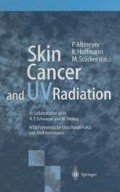Abstract
Msh2 is one of the genes involved in DNA-mismatch repair. Mutations in the coding region of the human gene (hmsh2) have been shown to be directly involved in microsatellite instability in hereditary nonpolyposis colorectal tumors. Examination of the promoter region of hmsh2 revealed a site with homology to the P53 consensus binding sequence. Using gel mobility shift experiments we were able to show that purified p53 has at least in vitro the potential to specifically bind the hmsh2-p53 motif. The binding activity was even stronger than the binding activity measured with the p53-consensus site. These data identify the hmsh2 gene as a possible novel p53-regulated target gene and indicate a direct involvement of p53 in repair mechanisms via DNA binding of a mismatch repair gene. Following UVB irradiation of human keratinocytes in cell culture we were able to transiently induce P53 expression with a subsequent increase in msh2-promoter binding activity, indicating a role of mismatch repair control after UVB damage. We are currently under way to examine in this context the involvement of microsatellite instability and the correlation of msh2 and p53 mutations in the pathogenesis of cutaneous melanoma using sections from paraffin-embedded tumor-tissue.
Access this chapter
Tax calculation will be finalised at checkout
Purchases are for personal use only
Preview
Unable to display preview. Download preview PDF.
References
Bronner CE, Baker SM, Morrison PT, Warren G, Smith LG, Lescoe MK, Kane M, Earabino C, Lipford, Lindblom A et al. (1994) Mutation in the DNA mismatch repair gene homologue hMLHl is associated with hereditary non-polyposis colon cancer. Nature 368: 258–261
Chomczynski P, Sacchi N (1987) Single-step method of RNA isolation by acid guanidinium thiocyanate-phenol-chloroform extraction. Anal Biochem 162:156–159
Dignam JD, Lebovitz RM, Roeder RG (1983) Accurate transcription initiation by RNA polymerase II in a soluble extract from isolated mammalian nuclei. Nucleic Acids Res 11: 1475–1489
Drummond JT, Li GM, Longley MJ, Modrich P (1995) Isolation of an hMSH2-p 160 heterodimer that restores DNA mismatch repair to tumor cells [see comments]. Science 268: 1909–1912
el-Deiry WS, Tokino T, Velculescu VE, Levy DB, Parsons R, Trent JM, Lin D, Mercer WE, Kinzler KW, Vogelstein B (1993) WAF1, a potential mediator of p53 tumor suppression. Cell 75: 817–825
Fishel R, Lescoe MK, Rao MR, Copeland NG, Jenkins NA, Garber J, Kane M, Kolodner R (1993) The human mutator gene homolog MSH2 and its association with hereditary nonpolypo- sis colon cancer [published erratum appears in Cell 1994 Apr 8;77(1):167]. Cell 75: 1027–1038
Harper JW, Adami GR, Wei N, Keyomarsi K, Elledge SJ (1993): The p21 Cdk-interacting protein Cipl is a potent inhibitor of G 1 cyclin-dependent kinases. Cell 75: 805–816
Kastan MB, Onyekwere O, Sidransky D, Vogelstein B, Craig RW (1991) Participation of p53 protein in the cellular response to DNA damage. Cancer Res 51: 6304–6311
Kastan MB, Zhan Q, el-Deiry WS, Carrier F, Jacks T, Walsh WV, Plunkett BS, Vogelstein B, Fornace AJJ (1992) A mammalian cell cycle checkpoint pathway utilizing p53 and GADD45 is defective in ataxia-telangiectasia. Cell 71: 587–597
Kimmerly WJ, Kyle AL, Lustre VM, Martin CH, Palazzolo MJ (1994) Direct sequencing of terminal regions of genomic PI clones. A general strategy for the design of sequence-tagged site markers. Genet Anal Tech Appl 11:117–128
Kinzler KW, Vogelstein B (1996) Life (and death) in a malignant tumor. Nature 379:19–20
Kolodner RD, Hall NR, Lipford J, Kane MF, Rao MRS, Morrison P, Finan PJ, Burn J, Chapman P, Earabino C, Merchant E, Bishop DT (1994) Structure of the human MSH2 locus and analysis of two Muir-Torre kindreds for msh2 mutations. Genomics 24: 516–526
Kuerbitz SJ, Plunkett BS, Walsh WV, Kastan MB (1992) Wild-type p53 is a cell cycle checkpoint determinant following irradiation. Proc Natl Acad Sci USA 89: 7491–7495
Loeb LA (1994): Microsatellite instability: marker of a mutator phenotype in cancer. Cancer Res 54: 5059–5063
Lu X, Lane DP (1993) Differential induction of transcriptionally active p53, following UV or ionizing radiation: defects in chromosome instability syndromes? Cell 75: 765–778
Morris GF, Bischoff JR, Mathews MB (1996) Transcriptional activation of the human prolifera ting-cell nuclear antigen promoter by p53. Proc Natl Acad Sci 93: 895–899
Oberosler P, Hloch P, Ramsperger U, Stahl H (1993) p53-catalyzed annealing of complementary single-stranded nucleic acids. EMBO J 12: 2389–2396
Papadopoulos N, Nicolaides NC, Wei YF, Ruben SM, Carter KC, Rosen CA, Haseltine WA, Fleischmann RD, Fraser CM, Adams MD et al. (1994) Mutation of a mutL homolog in hereditary colon cancer [see comments]. Science 263:1625–1629
Parsons R, Li GM, Longley MJ, Fang WH, Papadopoulos N, Jen J, de-la-Chapelle A, Kinzler KW, Vogelstein B, Modrich P (1993) Hypermutability and mismatch repair deficiency in RER+ tumor cells. Cell 75:1227–1236
Service RF (1994) Stalking the start of colon cancer. Science 263: 1559–1560
Smith ML, Chen IT, Zhan Q, Bae I, Chen CY, Gilmer TM, Kastan MB, O’Connor PM, Fornace AJJ (1994): Interaction of the p53-regulated protein Gadd45 with proliferating cell nuclear antigen [see comments]. Science 266:1376–1380
Wang XW, Yeh H, Schaeffer L, Roy R, Moncollin V, Egly JM, Wang Z, Freidberg EC, Evans MK, Taffe BG et al. (1995) p53 modulation of TFIIH-associated nucleotide excision repair activity. Nat Genet 10: 188–195
Wijnen J, Vasen H, Khan PM, Menko FH, van-der-Klift H, van-Leeuwen C, van-den-Broek M, van-Leeuwen-Cornelisse I, Nagengast F, Meijers-Heijboer A et al. (1995): Seven new mutations in hMSH2, an HNPCC gene, identified by denaturing gradient-gel electrophoresis. Am J Hum Genet 56:1060–1066
Editor information
Editors and Affiliations
Rights and permissions
Copyright information
© 1997 Springer-Verlag Berlin Heidelberg
About this paper
Cite this paper
Dooley, S. (1997). UVB Irradiation, Mismatch Repair and Cutaneous Melanoma. In: Altmeyer, P., Hoffmann, K., Stücker, M. (eds) Skin Cancer and UV Radiation. Springer, Berlin, Heidelberg. https://doi.org/10.1007/978-3-642-60771-4_88
Download citation
DOI: https://doi.org/10.1007/978-3-642-60771-4_88
Publisher Name: Springer, Berlin, Heidelberg
Print ISBN: 978-3-642-64547-1
Online ISBN: 978-3-642-60771-4
eBook Packages: Springer Book Archive

